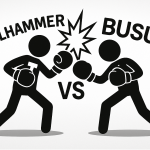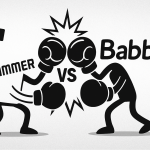Parents, teachers, and even young learners themselves often ask the same question: “What is the best language learning app for kids and teenagers?” The market is full of options – from the famous green owl of Duolingo to the science-based method of Taalhammer, and from flashcard tools like Quizlet to live tutoring on italki. But which of these apps actually work for young learners who need safe, effective, and motivating tools?
In this article, we compare 11 leading language learning apps – Taalhammer, Duolingo, Busuu, Babbel, Anki, Memrise, Lingvist, LingQ, italki, Glossika, and Quizlet – to find out which is the most effective for kids and teens in 2025. We’ll look at engagement, grammar and vocabulary depth, adaptivity, age-appropriateness, and long-term effectiveness.
- What Makes a Good Language Learning App for Kids and Teens?
- Taalhammer vs Duolingo for Kids
- Busuu, Babbel, Memrise and Lingvist – Structured vs Vocabulary Apps for Students
- Anki vs Quizlet for Students
- LingQ vs Glossika for Young Learners
- Is Taalhammer the best for young learners? Here’s the verdict!
- FAQs: Language Learning App for Young Learners
What Makes a Good Language Learning App for Kids and Teens?
Not every app that works for adults is automatically a good fit for children. Before comparing specific apps, let’s outline the key criteria that define a strong language learning app for young learners.
| Engagement and motivation |
|---|
| Gamification and visual design are crucial for younger children. |
| Teens benefit from progress tracking and achievements that keep them motivated. |
| Grammar and Vocabulary Depth |
|---|
| Apps that only teach isolated words risk leaving gaps. |
| Full-sentence practice and contextual grammar help kids understand how language really works. |
| Adaptivity and CEFR Alignment |
|---|
| Adaptive review ensures children remember what they learn. |
| CEFR-based progression (A1 to C2) is important for older learners aiming at exams. |
| Safety and Age-Appropriateness |
|---|
| Ads, distractions, or chat features can be unsuitable for kids. |
| A good app for young learners should provide a safe, parent-trusted environment. |
Things are a bit different for adult learners, you can read all about it in this article: Best Language Learning Apps for Adults in 2025: Smarter Tools for Serious Learners.
Taalhammer vs Duolingo for Kids
When it comes to kids’ learning, Duolingo is the household name, while Taalhammer is gaining attention for its science-based, sentence-driven method. Both promise progress, but they serve young learners differently.
Taalhammer for Young Learners
Strengths:
- Teaches full sentences right away, helping kids express ideas, not just words.
- Uses adaptive spaced repetition – kids review material just before forgetting.
- Covers the entire CEFR scale (A1–C2), so teens can prepare for exams.
- No distracting ads or unnecessary gamification.
Weak Points:
- Less colorful and playful compared to Duolingo.
Explore more: Taalhammer vs Duolingo: Which Language App Is Actually Better for Learning and for Whom?
Duolingo Kids and Duolingo App
Strengths:
- Fun gamification (streaks, leaderboards, rewards).
- The dedicated Duolingo ABC app is designed with simpler lessons for younger learners.
Weak Points:
- Exercises focus mostly on recognition (tapping, multiple choice).
- Grammar explanations are minimal.
- Kids may chase streaks more than actual learning.
| App | Strengths for Young Learners | Weak Points | Best For |
|---|---|---|---|
| Taalhammer | Sentence-based learning, adaptive review, CEFR scaffolding | Less playful visually | Kids/teens aiming for fluency or exams |
| Duolingo | Fun gamification, kid-friendly visuals | Recognition-heavy, limited grammar depth | Younger kids needing daily motivation |
Taalhammer or Duolingo?
- Duolingo is engaging and fun – a solid start for kids who need motivation.
- Taalhammer is more effective long-term – helping young learners actually speak and prepare for exams.
Why? Because, as we explain in Why One Language App Doesn’t Fit All, motivation alone doesn’t guarantee fluency – structured practice matters.
Busuu, Babbel, Memrise and Lingvist – Structured vs Vocabulary Apps for Students
When we move beyond the most famous names like Duolingo, parents and teachers often look at four other apps: Busuu, Babbel, Memrise, and Lingvist. Each claims to provide structured progress, but their actual usefulness for children and teens varies.
Busuu for Kids and Teens
Busuu’s main attraction is its community feature: learners can write short exercises and receive feedback from native speakers. This can be motivating for teenagers who enjoy interaction. Lessons also include dialogues that model real conversations. However, Busuu is clearly designed with adults in mind. The interface, topics, and corrections are not always child-friendly. It also caps at B2, so learners cannot reach advanced levels.
Strengths: real dialogues, community corrections.
Weak Points: adult-focused design, limited CEFR range.
Explore more: Taalhammer vs Busuu: Which App Is Better for Learning Germanic Languages?
Babbel for Children
Babbel takes a very structured approach. It offers grammar explanations, clear exercises, and practical phrases. For older teenagers, this kind of order can be reassuring, especially if they are preparing for exams or want methodical study. Younger children, however, will likely find it too dry. Babbel lessons resemble mini textbook chapters and, like Busuu, the app stops at B2.
Strengths: grammar explanations, structured lessons.
Weak Points: too formal for kids, not suitable beyond B2.
Related reading: Taalhammer vs Babbel: Which App Is Best for Learning Romance Languages in 2025?
Taalhammer vs Babbel
Comparing the two highlights Taalhammer’s strength. Where Babbel provides fixed lesson plans, Taalhammer adapts to the learner. Children repeat and practice sentences in a spaced repetition system that ensures memory retention, while Babbel risks leaving them stuck with rigid sequences.
More detail here: Taalhammer vs Babbel – Which Language Learning App Is Better and for Whom?
Memrise for Young Learners
Memrise has always leaned into fun and mnemonics. With video clips of native speakers and colorful design, it’s appealing for younger learners. Kids enjoy the bite-sized approach, and it’s more engaging than Babbel or Busuu. Yet the depth is limited: Memrise mainly teaches vocabulary, without scaffolding grammar or long-term progression. Children may enjoy it at the start but quickly outgrow it.
Strengths: playful design, native-speaker videos.
Weak Points: vocabulary-only focus, little CEFR guidance.
Read more: Taalhammer vs Memrise: Best Language App for Your Learning Style
Lingvist for Students
Lingvist positions itself as the data-driven app. It teaches high-frequency words quickly and efficiently, which can help motivated teenagers build exam vocabulary. But the design is very plain, almost clinical, and there is no grammar support. For young learners, it feels more like a memorization tool than a full learning system.
Strengths: fast vocabulary acquisition, minimalist.
Weak Points: dry interface, no grammar scaffolding.
Related: Taalhammer vs Lingvist – Which Language Learning App Has the Better Repetition System?
Taalhammer vs Lingvist
Placed side by side, Taalhammer and Lingvist both use spaced repetition, but in very different ways. Lingvist delivers lists of high-frequency words; Taalhammer integrates both grammar and vocabulary into full sentences, so children learn how to actually use the language in context, not just memorize it.
Read the deeper comparison: Best Language Learning Apps with Spaced Repetition (SRS) and AI in 2025
| App | Strengths for Kids/Teens | Weak Points | Best For |
|---|---|---|---|
| Busuu | Real dialogues, community feedback | Adult-oriented, limited to B2 | Teens who like interaction |
| Babbel | Clear grammar, structured lessons | Too formal for kids, stops at B2 | Older teens who prefer structure |
| Memrise | Playful design, native-speaker videos | Vocabulary-only, shallow depth | Kids at beginner stages |
| Lingvist | Fast vocabulary, efficient for exams | Dry design, no grammar | Motivated teens needing word boost |
Anki vs Quizlet for Students
Flashcard-based apps are popular with both teachers and students because they promise efficient memorization. Among them, Anki and Quizlet are the biggest names. Both are widely used in schools and universities, but their suitability for younger learners is very different.
Anki for Long-Term Retention
Anki is the classic spaced repetition system (SRS). It schedules flashcards so that words and facts reappear just before the learner forgets them. For disciplined teenagers, this is a powerful way to build long-term memory. However, Anki has almost no guidance for children. The interface is plain, importing decks can be tricky, and without a teacher’s help it can feel overwhelming. For kids, the steep learning curve makes it less practical.
Strengths: unbeatable retention through SRS, highly customizable.
Weak Points: steep setup, not child-friendly.
Related reading: The Best Anki Alternative for Modern Students
Taalhammer vs Anki
Anki’s strength is raw memorization, but it stops there. Taalhammer uses a similar spaced repetition principle, but applies it to full sentences and grammar patterns, not just single words. This makes it more effective for children who need structure as well as memory training.
Quizlet for Kids and Teens
Quizlet is far more school-friendly. Teachers can easily create sets, share them with classes, and let students practice through interactive games like Match or Gravity. For younger learners, this makes study sessions more fun. But the quality of learning depends entirely on the decks being used. Many are just isolated word lists, with little context or grammar. Quizlet is engaging, but not deep.
Strengths: fun games, easy classroom use, large library of shared decks.
Weak Points: inconsistent quality, vocabulary often out of context.
Explore more: Taalhammer vs Quizlet: Which language learning app is truly science-based?
Taalhammer vs Quizlet
Quizlet works well in classrooms for quick practice, but it rarely teaches how to use language beyond isolated vocabulary. Taalhammer, on the other hand, helps children practice meaningful sentences with adaptive review, making it more robust for building fluency.
| App | Strengths for Kids/Teens | Weak Points | Best For |
|---|---|---|---|
| Anki | Powerful spaced repetition, customizable | Complex setup, unfriendly UI | Highly motivated teens |
| Quizlet | Fun games, classroom use, huge library | Word lists, inconsistent sets | Kids in school needing practice |
LingQ vs Glossika for Young Learners
When you move away from flashcards and drills, LingQ and Glossika represent a different philosophy: input-driven, sentence-based learning. Both appeal more to serious learners, but for kids and teens, their suitability diverges in key ways.
LingQ for Kids and Teens
LingQ is built around massive reading & listening. Learners import texts and audio, highlight new words, and listen repeatedly. The idea is exposure over time. This is powerful – vocabulary always lives in context, and learners see patterns naturally.
But for younger learners, it can feel heavy. The interface is text-centric, and without fun elements or gamification, engagement can drop. Also, because LingQ doesn’t explicitly teach grammar, some students may struggle without supplementary instruction.
Strengths:
- Authentic, contextual exposure via real texts and audio.
- Vocabulary is learned in meaning-heavy contexts.
- Good for motivated teens who enjoy reading/listening.
Weak Points:
- Very little built-in corrective feedback or grammar explanation.
- Design may feel dry or overwhelming to younger learners.
- Requires self-discipline and external scaffolding.
Glossika for Kids and Teens
Glossika’s philosophy is repetition of full sentences. Learners listen, repeat, and internalize structures through mass sentence-based exposure. This helps with fluency and pattern recognition, especially in producing natural sentence forms.
But the format is uniform and repetitive – the same rhythm over and over. For children navigating school, this lack of variety can lead to boredom. Also, Glossika offers minimal explicit grammar explanation or error correction – learners largely self-monitor.
Strengths:
- Strong focus on fluency and sentence rhythm.
- Builds pattern familiarity via mass repetition.
Weak Points:
- Repetitive format can feel monotonous.
- Minimal explanation or feedback.
- Less engaging for younger learners who prefer diversity in format.
See how that compares: Which Language Learning App Helps You Become Fluent? Taalhammer vs Busuu, Glossika and 3 More
Taalhammer vs Glossika
While Glossika leans heavily on repetition, Taalhammer combines repetition with meaning and adaptivity. Where Glossika repeats sentences, Taalhammer ensures children understand, correct mistakes, and revisit items just before forgetting – all within context. This mixture gives Taalhammer an edge for sustained, meaningful progress.
| App | Strengths for Kids/Teens | Weak Points | Best For |
|---|---|---|---|
| LingQ | Rich contextual input, vocabulary in context | Dry UI, minimal feedback, steep discipline | Teens who love reading/listening |
| Glossika | Fluency-focused, pattern internalization via repetition | Monotonous format, little explanation or correction | Learners seeking natural sentence rhythm |
Is Taalhammer the best for young learners? Here’s the verdict!
Choosing the best language learning app for young learners depends on what you want. Some apps are playful, others highly structured, and some focus on memorization alone. But if your goal is not just to keep kids entertained but to help them actually learn a language, prepare for exams, and build fluency, one option stands out. —
Taalhammer is the only app that blends scientific adaptivity, full-sentence practice, grammar in context, and CEFR progression from A1 to C2. It’s serious enough for teens aiming for certificates, but simple enough for younger learners to start expressing themselves right away.
For parents and teachers looking for the most effective language app in 2025, Taalhammer is the clear winner.
FAQs: Language Learning App for Young Learners
Which is better: Duolingo or Taalhammer for kids?
Duolingo is fun for quick practice, but Taalhammer is better for fluency and exam readiness because it teaches full sentences with adaptive review.
What is the best free language learning app for children?
Duolingo, because of its free access and kid-friendly gamification.
What is the safest language learning app for students?
Taalhammer and Duolingo Kids both avoid unsafe chat features. Taalhammer also avoids ads, making it more parent-trusted.
Which app helps kids practice speaking?
italki is strongest for real conversations, but Taalhammer also encourages sentence production that builds speaking confidence.
What is the most effective language learning app for teenagers?
Taalhammer, because it offers CEFR progression, adaptive practice, and the kind of structured content teens need for school and exams.
Are paid language apps worth it for children?
Yes, when they provide real value. Free apps keep kids engaged, but paid apps like Taalhammer offer science-based methods that support measurable long-term progress.








